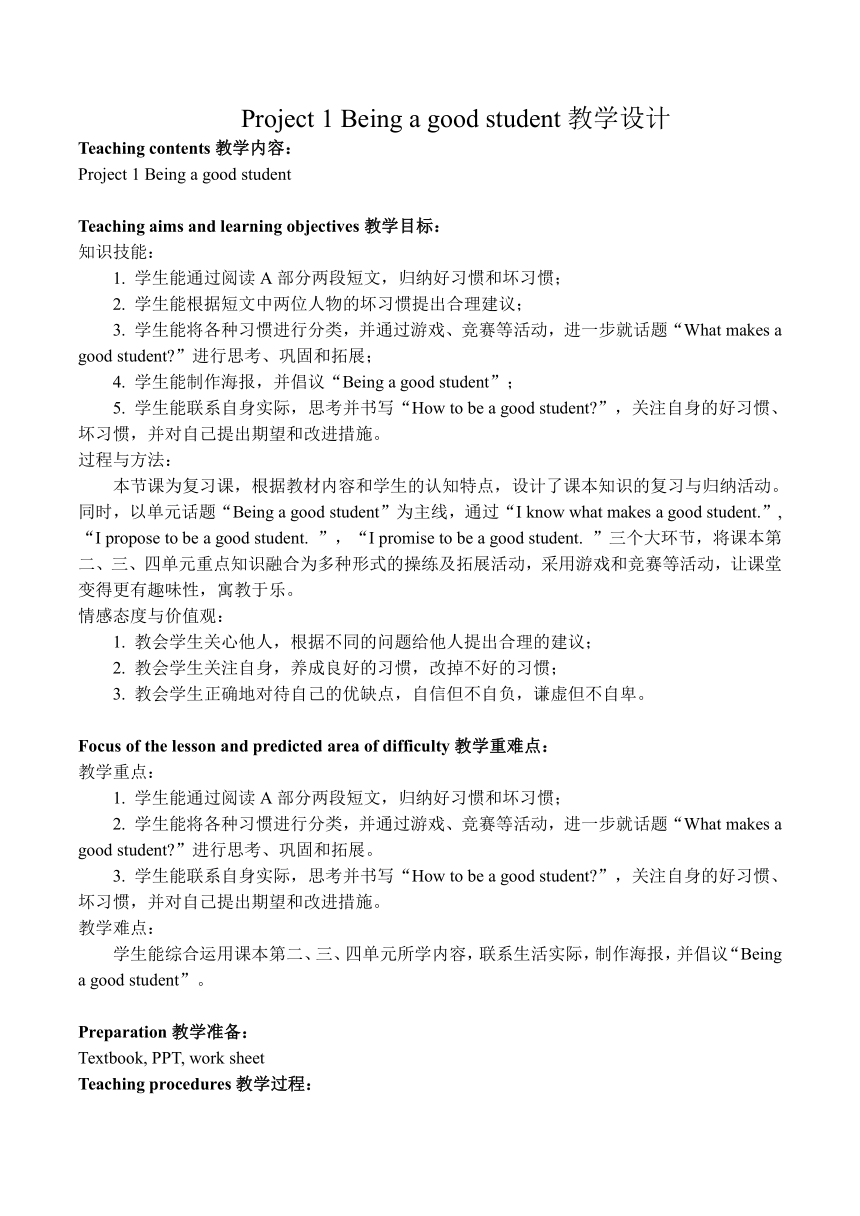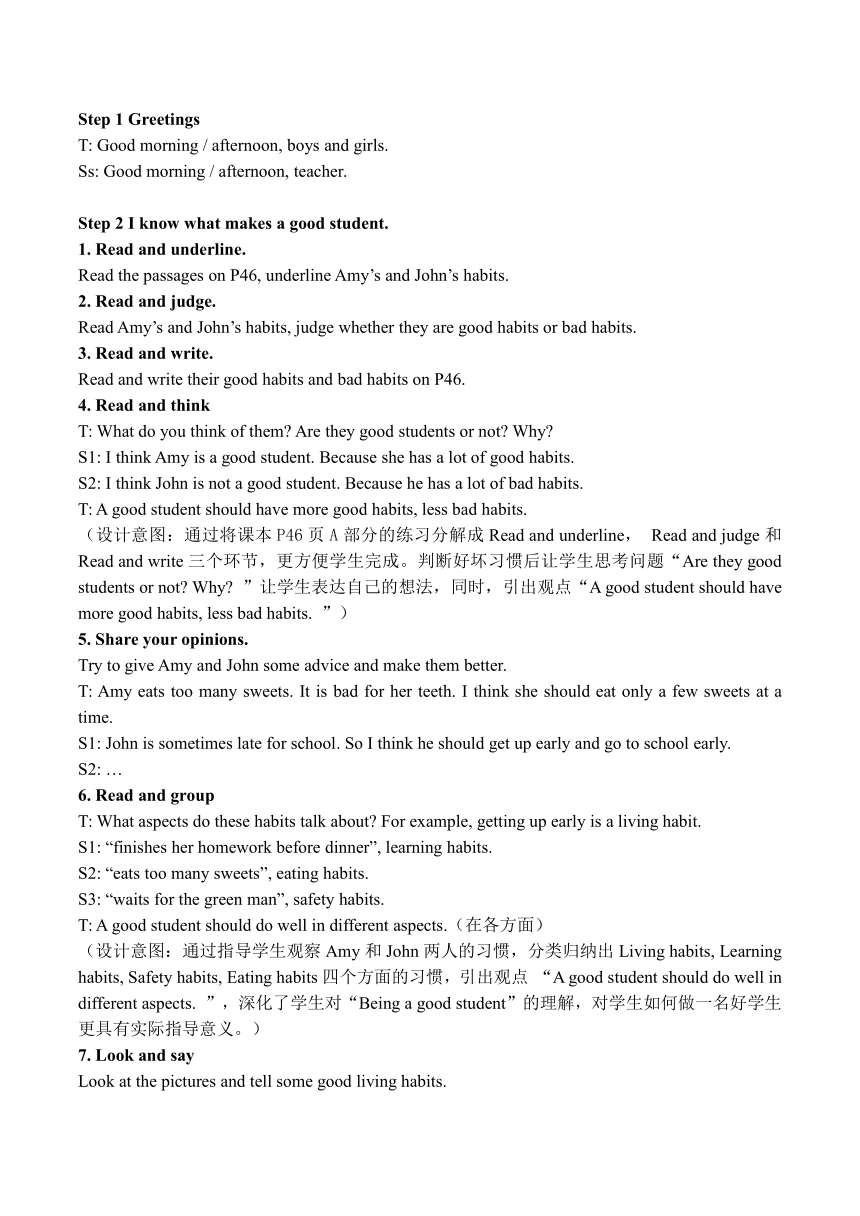牛津译林版小学英语六年级下册 Project 1 Being a good student part A 教案
文档属性
| 名称 | 牛津译林版小学英语六年级下册 Project 1 Being a good student part A 教案 |  | |
| 格式 | doc | ||
| 文件大小 | 133.0KB | ||
| 资源类型 | 教案 | ||
| 版本资源 | 牛津译林版 | ||
| 科目 | 英语 | ||
| 更新时间 | 2022-04-02 07:55:39 | ||
图片预览


文档简介
Project 1 Being a good student教学设计
Teaching contents教学内容:
Project 1 Being a good student
Teaching aims and learning objectives教学目标:
知识技能:
1. 学生能通过阅读A部分两段短文,归纳好习惯和坏习惯;
2. 学生能根据短文中两位人物的坏习惯提出合理建议;
3. 学生能将各种习惯进行分类,并通过游戏、竞赛等活动,进一步就话题“What makes a good student ”进行思考、巩固和拓展;
4. 学生能制作海报,并倡议“Being a good student”;
5. 学生能联系自身实际,思考并书写“How to be a good student ”,关注自身的好习惯、坏习惯,并对自己提出期望和改进措施。
过程与方法:
本节课为复习课,根据教材内容和学生的认知特点,设计了课本知识的复习与归纳活动。同时,以单元话题“Being a good student”为主线,通过“I know what makes a good student.”, “I propose to be a good student. ”,“I promise to be a good student. ”三个大环节,将课本第二、三、四单元重点知识融合为多种形式的操练及拓展活动,采用游戏和竞赛等活动,让课堂变得更有趣味性,寓教于乐。
情感态度与价值观:
1. 教会学生关心他人,根据不同的问题给他人提出合理的建议;
2. 教会学生关注自身,养成良好的习惯,改掉不好的习惯;
3. 教会学生正确地对待自己的优缺点,自信但不自负,谦虚但不自卑。
Focus of the lesson and predicted area of difficulty教学重难点:
教学重点:
1. 学生能通过阅读A部分两段短文,归纳好习惯和坏习惯;
2. 学生能将各种习惯进行分类,并通过游戏、竞赛等活动,进一步就话题“What makes a good student ”进行思考、巩固和拓展。
3. 学生能联系自身实际,思考并书写“How to be a good student ”,关注自身的好习惯、坏习惯,并对自己提出期望和改进措施。
教学难点:
学生能综合运用课本第二、三、四单元所学内容,联系生活实际,制作海报,并倡议“Being a good student”。
Preparation教学准备:
Textbook, PPT, work sheet
Teaching procedures教学过程:
Step 1 Greetings
T: Good morning / afternoon, boys and girls.
Ss: Good morning / afternoon, teacher.
Step 2 I know what makes a good student.
1. Read and underline.
Read the passages on P46, underline Amy’s and John’s habits.
2. Read and judge.
Read Amy’s and John’s habits, judge whether they are good habits or bad habits.
3. Read and write.
Read and write their good habits and bad habits on P46.
4. Read and think
T: What do you think of them Are they good students or not Why
S1: I think Amy is a good student. Because she has a lot of good habits.
S2: I think John is not a good student. Because he has a lot of bad habits.
T: A good student should have more good habits, less bad habits.
(设计意图:通过将课本P46页A部分的练习分解成Read and underline, Read and judge和Read and write三个环节,更方便学生完成。判断好坏习惯后让学生思考问题“Are they good students or not Why ”让学生表达自己的想法,同时,引出观点“A good student should have more good habits, less bad habits. ”)
5. Share your opinions.
Try to give Amy and John some advice and make them better.
T: Amy eats too many sweets. It is bad for her teeth. I think she should eat only a few sweets at a time.
S1: John is sometimes late for school. So I think he should get up early and go to school early.
S2: …
6. Read and group
T: What aspects do these habits talk about For example, getting up early is a living habit.
S1: “finishes her homework before dinner”, learning habits.
S2: “eats too many sweets”, eating habits.
S3: “waits for the green man”, safety habits.
T: A good student should do well in different aspects.(在各方面)
(设计意图:通过指导学生观察Amy和John两人的习惯,分类归纳出Living habits, Learning habits, Safety habits, Eating habits四个方面的习惯,引出观点 “A good student should do well in different aspects. ”,深化了学生对“Being a good student”的理解,对学生如何做一名好学生更具有实际指导意义。)
7. Look and say
Look at the pictures and tell some good living habits.
We brush our teeth _______ .
We keep our room _______ .
We go to bed _______ .
We _______ at home.
We do not _______ .
We _______ smoke.
We do not use _______ plastic.
We _______ water.
We can not _______ food.
8. Have a competition
a. Tic-tac-toe
Use the phrases to tell some good learning habits.
b. Think and say (On the road)
Boy 1: A good student should(n’t) / must(n’t) …
Girl 1: A good student should(n’t) / must(n’t) …
c. Think and say (at home)
Boy 1: A good student should / must …
Girl 1: A good student should(n’t) / must(n’t) …
d. Look and choose (at school)
T: Please look at the picture and tell us what a good student should(n’t) / must(n’t) do at school.
A. eat or drink
B. keep quiet
C. play in the classroom
D. chase(追赶)each other
E. be late for school
F. draw on the desks
G. listen to our teachers in class
T: Now we know “A good student should do well at anytime and anywhere.”
(设计意图:通过字棋游戏等三轮男女生竞赛,引导学生重点关注作为一位好学生“在家”、“在马路上”和“在学校”应该做什么,不应该做什么,从而引出观点 “A good student should do well in different aspects. ”,继续深化学生对“Being a good student”的理解,对学生如何做一名好学生做出更具体的指导。)
Step 3 I propose to be a good student.
T: It’s time for you to propose to be a good student. Please bring your poster to the front and tell us your opinion. Make sure to be confident. And other student should listen carefully.
S1: To be a good student, we should … We shouldn’t …
(设计意图:为了节省课堂时间,课前让学生做好了“Being a good student”的海报,课堂上让学生进行展示。经过课堂前半部分的学习,学生对“What makes a good student ”有了更深的认识。这一环节重点在给学生创造机会,向全班同学发出倡议 “Being a good student”,增强了学生的主人翁意识和责任意识。)
Step 4 I promise to be a good student.
1. Think and write
T: You list so many good habits here. Can you do all of them
S: No.
T: We all have good habits and bad habits. No one is perfect(完美). Get rid of(改掉)your bad habits. You can be a good student. Please think about how to get rid of your habits and write down your plans.
2. Show your plans.
T: Please come to the front and show us your plan.
S1: I want to be a good student. I have many good habits. …
I also have some bad habits. … I should …
(设计意图:经过前两个板块的学习和实践,学生已经知道了做一名好学生应该具备的好习惯,这里让学生联系自身实际情况,思考总结自己所具备的好习惯,以及需要改正的坏习惯,并制订改进计划,以此作为自己努力的方向,实现了“以学促行”。 )
Blackboard design板书设计:
Teaching contents教学内容:
Project 1 Being a good student
Teaching aims and learning objectives教学目标:
知识技能:
1. 学生能通过阅读A部分两段短文,归纳好习惯和坏习惯;
2. 学生能根据短文中两位人物的坏习惯提出合理建议;
3. 学生能将各种习惯进行分类,并通过游戏、竞赛等活动,进一步就话题“What makes a good student ”进行思考、巩固和拓展;
4. 学生能制作海报,并倡议“Being a good student”;
5. 学生能联系自身实际,思考并书写“How to be a good student ”,关注自身的好习惯、坏习惯,并对自己提出期望和改进措施。
过程与方法:
本节课为复习课,根据教材内容和学生的认知特点,设计了课本知识的复习与归纳活动。同时,以单元话题“Being a good student”为主线,通过“I know what makes a good student.”, “I propose to be a good student. ”,“I promise to be a good student. ”三个大环节,将课本第二、三、四单元重点知识融合为多种形式的操练及拓展活动,采用游戏和竞赛等活动,让课堂变得更有趣味性,寓教于乐。
情感态度与价值观:
1. 教会学生关心他人,根据不同的问题给他人提出合理的建议;
2. 教会学生关注自身,养成良好的习惯,改掉不好的习惯;
3. 教会学生正确地对待自己的优缺点,自信但不自负,谦虚但不自卑。
Focus of the lesson and predicted area of difficulty教学重难点:
教学重点:
1. 学生能通过阅读A部分两段短文,归纳好习惯和坏习惯;
2. 学生能将各种习惯进行分类,并通过游戏、竞赛等活动,进一步就话题“What makes a good student ”进行思考、巩固和拓展。
3. 学生能联系自身实际,思考并书写“How to be a good student ”,关注自身的好习惯、坏习惯,并对自己提出期望和改进措施。
教学难点:
学生能综合运用课本第二、三、四单元所学内容,联系生活实际,制作海报,并倡议“Being a good student”。
Preparation教学准备:
Textbook, PPT, work sheet
Teaching procedures教学过程:
Step 1 Greetings
T: Good morning / afternoon, boys and girls.
Ss: Good morning / afternoon, teacher.
Step 2 I know what makes a good student.
1. Read and underline.
Read the passages on P46, underline Amy’s and John’s habits.
2. Read and judge.
Read Amy’s and John’s habits, judge whether they are good habits or bad habits.
3. Read and write.
Read and write their good habits and bad habits on P46.
4. Read and think
T: What do you think of them Are they good students or not Why
S1: I think Amy is a good student. Because she has a lot of good habits.
S2: I think John is not a good student. Because he has a lot of bad habits.
T: A good student should have more good habits, less bad habits.
(设计意图:通过将课本P46页A部分的练习分解成Read and underline, Read and judge和Read and write三个环节,更方便学生完成。判断好坏习惯后让学生思考问题“Are they good students or not Why ”让学生表达自己的想法,同时,引出观点“A good student should have more good habits, less bad habits. ”)
5. Share your opinions.
Try to give Amy and John some advice and make them better.
T: Amy eats too many sweets. It is bad for her teeth. I think she should eat only a few sweets at a time.
S1: John is sometimes late for school. So I think he should get up early and go to school early.
S2: …
6. Read and group
T: What aspects do these habits talk about For example, getting up early is a living habit.
S1: “finishes her homework before dinner”, learning habits.
S2: “eats too many sweets”, eating habits.
S3: “waits for the green man”, safety habits.
T: A good student should do well in different aspects.(在各方面)
(设计意图:通过指导学生观察Amy和John两人的习惯,分类归纳出Living habits, Learning habits, Safety habits, Eating habits四个方面的习惯,引出观点 “A good student should do well in different aspects. ”,深化了学生对“Being a good student”的理解,对学生如何做一名好学生更具有实际指导意义。)
7. Look and say
Look at the pictures and tell some good living habits.
We brush our teeth _______ .
We keep our room _______ .
We go to bed _______ .
We _______ at home.
We do not _______ .
We _______ smoke.
We do not use _______ plastic.
We _______ water.
We can not _______ food.
8. Have a competition
a. Tic-tac-toe
Use the phrases to tell some good learning habits.
b. Think and say (On the road)
Boy 1: A good student should(n’t) / must(n’t) …
Girl 1: A good student should(n’t) / must(n’t) …
c. Think and say (at home)
Boy 1: A good student should / must …
Girl 1: A good student should(n’t) / must(n’t) …
d. Look and choose (at school)
T: Please look at the picture and tell us what a good student should(n’t) / must(n’t) do at school.
A. eat or drink
B. keep quiet
C. play in the classroom
D. chase(追赶)each other
E. be late for school
F. draw on the desks
G. listen to our teachers in class
T: Now we know “A good student should do well at anytime and anywhere.”
(设计意图:通过字棋游戏等三轮男女生竞赛,引导学生重点关注作为一位好学生“在家”、“在马路上”和“在学校”应该做什么,不应该做什么,从而引出观点 “A good student should do well in different aspects. ”,继续深化学生对“Being a good student”的理解,对学生如何做一名好学生做出更具体的指导。)
Step 3 I propose to be a good student.
T: It’s time for you to propose to be a good student. Please bring your poster to the front and tell us your opinion. Make sure to be confident. And other student should listen carefully.
S1: To be a good student, we should … We shouldn’t …
(设计意图:为了节省课堂时间,课前让学生做好了“Being a good student”的海报,课堂上让学生进行展示。经过课堂前半部分的学习,学生对“What makes a good student ”有了更深的认识。这一环节重点在给学生创造机会,向全班同学发出倡议 “Being a good student”,增强了学生的主人翁意识和责任意识。)
Step 4 I promise to be a good student.
1. Think and write
T: You list so many good habits here. Can you do all of them
S: No.
T: We all have good habits and bad habits. No one is perfect(完美). Get rid of(改掉)your bad habits. You can be a good student. Please think about how to get rid of your habits and write down your plans.
2. Show your plans.
T: Please come to the front and show us your plan.
S1: I want to be a good student. I have many good habits. …
I also have some bad habits. … I should …
(设计意图:经过前两个板块的学习和实践,学生已经知道了做一名好学生应该具备的好习惯,这里让学生联系自身实际情况,思考总结自己所具备的好习惯,以及需要改正的坏习惯,并制订改进计划,以此作为自己努力的方向,实现了“以学促行”。 )
Blackboard design板书设计:
